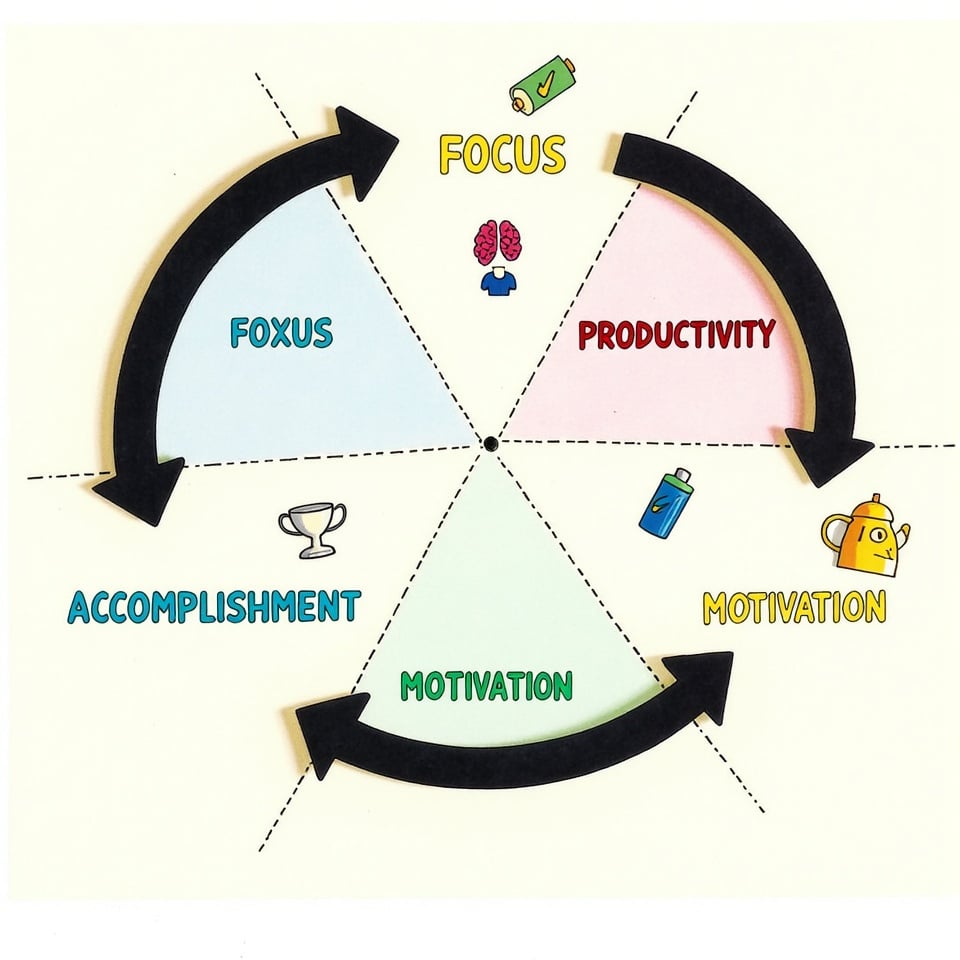Are you feeling overwhelmed by your never-ending to-do list each week? You’re not alone.
Many professionals struggle to stay on top of their tasks, leading to stress and burnout. But what if I told you that setting weekly goals could be the game-changer you need?
By breaking your workload into manageable, focused objectives, you can boost your productivity and regain control over your time.
In this article, you’ll discover the step-by-step process for creating effective weekly goals that align with your long-term vision.
Get ready to transform your planning strategy and achieve more with less stress!
Why Traditional Goal Setting Methods Often Fail
While many people start each year with ambitious resolutions and goals, traditional goal-setting approaches often lead to disappointment and abandonment within weeks.
You’re not alone if you’ve experienced this frustration – the problem often lies in the method itself.
Traditional goal setting frequently fails because it relies on vague objectives that aren’t broken down into manageable tasks.
You’ll likely lose motivation when you can’t measure your progress or see clear steps forward.
Without specific criteria for success, you’ll struggle to track improvements or know when you’ve achieved your goals.
Even worse, if your goals don’t align with your personal values, you’ll find it hard to stay committed.
The key is recognizing these common pitfalls so you can adapt your approach and create a more effective goal-setting strategy.
The Science Behind Effective Weekly Goals
Understanding the science behind effective weekly goals reveals fascinating insights into why certain goal-setting approaches succeed while others fall short.
When you set weekly goals, you’re tapping into powerful psychological mechanisms that drive achievement and personal growth.
- Writing down your goals makes you 42% more likely to achieve your goals compared to keeping them in your head.
- Your brain releases dopamine when you complete small tasks, creating a positive feedback loop.
- Breaking larger objectives into weekly chunks reduces anxiety and builds confidence.
- SMART goals activate your brain’s goal-pursuit systems more effectively than vague intentions.
- Weekly reflection strengthens neural pathways associated with learning and growth.
Reviewing previous week performance first
Before diving into new weekly goals, taking time to review your previous week’s performance provides essential insights that can shape your future success.
You’ll want to track your progress by examining both achievements and setbacks, which helps you make smarter decisions moving forward.
| Review Area | What to Analyze | Why It Matters |
|---|---|---|
|
🎯
Goals Met
|
Completed tasks | 💪 Builds confidence |
|
🚧
Challenges
|
Obstacles faced | 📈 Improves strategy |
|
⏰
Time Usage
|
Productivity patterns | ⚡ Enhances efficiency |
When reviewing previous week performance, focus on understanding what worked well and what didn’t.
Look for patterns in your productivity, identify time-wasting activities, and celebrate your wins.
This reflection process isn’t about criticism – it’s about learning and growth. You’ll find that regular reviews help you set more realistic goals and develop better strategies for achieving them.
5 Essential Characteristics of Powerful Weekly Goals
When setting powerful weekly goals, certain essential characteristics can make the difference between success and disappointment.
Your achievable goals should follow a clear framework that keeps you motivated and focused.
Tracking your weekly goals becomes natural when you incorporate these crucial elements:
- Make each goal specific and measurable, so you’ll know exactly when you’ve succeeded
- Choose realistic targets that stretch your abilities without overwhelming you
- Align your weekly objectives with your bigger life aspirations
- Break down complex goals into smaller, manageable action steps
- Set firm deadlines to create urgency and maintain momentum
Step-by-Step Process to Set Your Weekly Goals
Setting effective weekly goals starts with a dedicated Sunday planning session where you’ll map out your priorities and review last week’s accomplishments.
You’ll want to break down your monthly targets into bite-sized weekly tasks, making sure to assign specific days for different types of activities that align with your energy levels and schedule.
Your goal-setting process becomes more powerful when you use strategic prioritization techniques to rank tasks by importance and urgency, ensuring you’re focusing on what truly matters each week.
#1 Establish a Sunday Planning Ritual for the Week Ahead
The strategic Sunday planning ritual serves as your foundation for a productive week ahead.
When you set your goals and track your goals effectively, you’ll join countless others who’ve mastered the art of weekly planning.
By dedicating 30 minutes each Sunday evening, you’re investing in your success alongside a community of goal-achievers.
- Review last week’s accomplishments and setbacks to gain valuable insights for moving forward
- Write down your top three priorities that align with your long-term vision
- Break larger goals into daily actionable tasks that feel manageable and clear
- Schedule specific time blocks for each goal, respecting your natural energy patterns
- Create accountability by sharing your weekly plan with a mentor or trusted friend
This structured approach transforms your Sunday evening into a powerful launching pad for the week ahead.
#2 Conduct a Thorough Review of Previous Week Performance
Success leaves clues, and your past week’s performance holds valuable insights for the future.
To track your weekly goals effectively, dedicate time each Sunday to evaluate your accomplishments and setbacks.
Start by listing what you achieved and what fell short.
Did you complete that major project?
Did your morning routine stick?
Be honest with yourself – this isn’t about judgment but growth.
Next, identify patterns in your successes and challenges. Maybe you’re most productive in the morning, or certain distractions consistently derail your progress.
Finally, connect these insights to your bigger picture.
Ask yourself: Did last week’s goals align with your values and long-term vision?
Use this reflection to adjust your approach and set SMART goals that build on what’s working while addressing what isn’t.
#3 Apply Strategic Prioritization Techniques for Weekly Tasks
Strategic prioritization forms the backbone of effective weekly goal-setting. When you prioritize tasks effectively, you’ll transform your scattered to-do list into a focused action plan that drives results.
Using tools like the Eisenhower Matrix, you can sort your activities based on urgency and importance, ensuring you’re always working on what matters most.
- Start by listing everything you need to accomplish this week
- Identify your top three “must-complete” priorities that align with long-term goals
- Block specific time slots for each task in your calendar
- Allocate buffer time for unexpected challenges or opportunities
- Group similar tasks together to maximize efficiency
#4 Transform Monthly Objectives into Actionable Weekly Chunks
Moving from daily task management to broader planning horizons, you’ll need a systematic approach to break down your monthly goals into weekly action items.
Start by reviewing your monthly objectives and identifying the key milestones you’ll need to achieve weekly goals successfully.
Break down each monthly goal into four distinct weekly chunks, ensuring they’re manageable and aligned with your overall vision.
For example, if your monthly goal is to complete a major project, you might:
Week 1: Research and outline
Week 2: Create first draft
Week 3: Gather feedback and revise
Week 4: Polish and finalize
#5 Strategically Allocate Specific Days for Different Goal Categories
Creating an effective weekly routine starts with dedicating specific days to different goal categories. When setting weekly goals, you’ll find that this structured approach helps maintain focus and build momentum throughout the week.
Here’s how to organize your weekly goal ideas:
- Make Mondays your personal development day, tackling skills and learning objectives that align with your growth.
- Focus on health and fitness goals every Tuesday to prioritize your well-being early in the week.
- Dedicate Wednesdays to career advancement activities and professional objectives.
- Use Thursdays for reflection and progress evaluation to stay on track.
- Reserve Fridays for creative pursuits and social connections, creating balance in your routine.
This strategic allocation guarantees you’re addressing all aspects of your life while maintaining consistency in your weekly planning process.
Allocating specific days for different goal categories
When you designate specific days for different goal categories, you’ll create a powerful structure that maximizes your productivity and focus.
Using your weekly planner, establish themed days that align with your priorities – for example, “Mindful Mondays” for personal growth or “Fitness Fridays” for health goals.
Weekly Goal Setting Tools
The right tools can transform your weekly goal-setting process from overwhelming to effortless.
When you’re setting effective goals, having the proper resources at your fingertips makes all the difference in tracking and achieving your targets.
Here’s what you’ll need to maximize your goal progress:
- A digital goal-tracking app that sends customized reminders and keeps you focused
- A dedicated journal to record your journey, challenges, and wins along the way
- Visual progress charts or graphs that showcase your achievements in real-time
- An accountability partner who’ll support your growth and keep you on track
- A weekly review system that helps you assess and adjust your goals as needed
These essential tools work together to create a robust framework that supports your success and keeps you moving forward consistently.
How to Connect Weekly Goals to Larger Life Objectives
Successful weekly goals serve as stepping stones toward your bigger life aspirations.
To create meaningful goals for the week, start by visualizing your long-term goals and breaking them down into actionable steps.
You’ll find greater motivation when you understand how today’s efforts connect to tomorrow’s dreams.
Begin by mapping out your major life objectives, then identify specific weekly milestones that move you closer to these targets.
For example, if your long-term goal is to own a business, your weekly goals might include researching market trends or networking with industry professionals.
Remember to use the SMART framework to keep your goals focused and achievable.
At the end of each week, review your progress and celebrate how these smaller accomplishments align with your bigger vision, adjusting your approach as needed.
Accountability Systems for Weekly Goal Achievement
Building an effective accountability system transforms your weekly goals from mere wishes into concrete achievements. Finding an accountability partner who’ll check in with you regularly creates the structure you need to stay committed.
When you’re tracking progress visually through charts or checklists, you’ll see your momentum building week after week.
- Share your weekly targets with a trusted friend or mentor who won’t let you make excuses
- Set up regular check-in times that work for both your schedules
- Create a progress tracking method that excites and motivates you
- Celebrate small wins with your accountability partner to build momentum
- Schedule weekly reflection sessions to review what’s working and what isn’t
Troubleshooting Common Weekly Goal Challenges
When you’re pursuing weekly goals, you’ll inevitably face obstacles that can derail your progress. The key is to approach these challenges systematically and with flexibility.
If you’re struggling to stay accountable, partner with a trusted friend or colleague who can check in on your progress regularly.
When tasks feel overwhelming, break them down into smaller, more manageable steps. Can’t complete everything you planned? Don’t get discouraged—instead, reassess and set new goals that better align with your current circumstances.
Remember that adaptation is part of the process.
Keep a progress journal to track what’s working and what isn’t. This helps you identify patterns and adjust your approach accordingly.
If you consistently miss certain goals, consider whether they’re truly realistic or if you need to modify your timeline.
Wrapping it up
You’re now equipped to transform your weekly goal-setting process from scattered wishes into strategic accomplishments.
Research shows that people who write down their goals are 42% more likely to achieve them than those who don’t.
By implementing the structured approach outlined above, reviewing your progress regularly, and staying accountable, you’ll find yourself consistently hitting targets and building momentum toward your larger life objectives.
Start your weekly planning ritual today.







